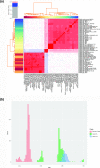Phylogenomic analysis of the genus Delftia reveals distinct major lineages with ecological specializations
- PMID: 36107145
- PMCID: PMC9676026
- DOI: 10.1099/mgen.0.000864
Phylogenomic analysis of the genus Delftia reveals distinct major lineages with ecological specializations
Abstract
Delftia is a diverse betaproteobacterial genus with many strains having agricultural and industrial relevance, including plant-growth promotion, bioremediation of hydrocarbon-contaminated soils, and heavy metal immobilization. Delftia spp. are broadly distributed in the environment, and have been isolated from plant hosts as well as healthy and diseased animal hosts, yet the genetic basis of this ecological versatility has not been characterized. Here, we present a phylogenomic comparison of published Delftia genomes and show that the genus is divided into two well-supported clades: one 'Delftia acidovorans' clade with isolates from soils and plant rhizospheres, and a second 'Delftia lacustris and Delftia tsuruhatensis' clade with isolates from humans and sludge. The pan-genome inferred from 61 Delftia genomes contained over 28 000 genes, of which only 884 were found in all genomes. Analysis of industrially relevant functions highlighted the ecological versatility of Delftia and supported their role as generalists.
Keywords: Delftia; gold metabolism; plant-growth promotion.
Conflict of interest statement
The authors declare that there are no conflicts of interest.
Figures



Similar articles
-
Delftia deserti sp. nov., isolated from a desert soil sample.Antonie Van Leeuwenhoek. 2015 Jun;107(6):1445-50. doi: 10.1007/s10482-015-0440-4. Epub 2015 Apr 5. Antonie Van Leeuwenhoek. 2015. PMID: 25842037
-
Genome sequencing reveals mechanisms for heavy metal resistance and polycyclic aromatic hydrocarbon degradation in Delftia lacustris strain LZ-C.Ecotoxicology. 2016 Jan;25(1):234-47. doi: 10.1007/s10646-015-1583-9. Epub 2015 Nov 20. Ecotoxicology. 2016. PMID: 26589947
-
Delftia rhizosphaerae sp. nov. isolated from the rhizosphere of Cistus ladanifer.Int J Syst Evol Microbiol. 2017 Jun;67(6):1957-1960. doi: 10.1099/ijsem.0.001892. Epub 2017 Jun 20. Int J Syst Evol Microbiol. 2017. PMID: 28629496
-
A critical review of the bioavailability and impacts of heavy metals in municipal solid waste composts compared to sewage sludge.Environ Int. 2009 Jan;35(1):142-56. doi: 10.1016/j.envint.2008.06.009. Epub 2008 Aug 8. Environ Int. 2009. PMID: 18691760 Review.
-
Delftia lacustris septicemia in a pheochromocytoma patient: case report and literature review.Infect Dis (Lond). 2015 May;47(5):349-53. doi: 10.3109/00365548.2014.993422. Epub 2015 Feb 24. Infect Dis (Lond). 2015. PMID: 25712727 Review.
Cited by
-
Genomic analysis of multidrug-resistant Delftia tsuruhatensis isolated from raw bovine milk.Front Microbiol. 2024 Jan 4;14:1321122. doi: 10.3389/fmicb.2023.1321122. eCollection 2023. Front Microbiol. 2024. PMID: 38239723 Free PMC article.
-
Complete genome sequence of Delftia tsuruhatensis strain HA60 isolated from a commercial hydroxyapatite nano-particle product (nano-hydroxyapatite).Microbiol Resour Announc. 2024 Jun 11;13(6):e0017124. doi: 10.1128/mra.00171-24. Epub 2024 May 3. Microbiol Resour Announc. 2024. PMID: 38700346 Free PMC article.
-
Characterization and Genomic Analysis of the Naphthalene-Degrading Delftia tsuruhatensis ULwDis3 Isolated from Seawater.Microorganisms. 2023 Apr 21;11(4):1092. doi: 10.3390/microorganisms11041092. Microorganisms. 2023. PMID: 37110515 Free PMC article.
-
Assessing the Effects of Surface-Stabilized Zero-Valent Iron Nanoparticles on Diverse Bacteria Species Using Complementary Statistical Models.J Funct Biomater. 2025 Mar 20;16(3):113. doi: 10.3390/jfb16030113. J Funct Biomater. 2025. PMID: 40137392 Free PMC article.
-
Ensiling hybrid Pennisetum with lactic acid bacteria or organic acids improved the fermentation quality and bacterial community.Front Microbiol. 2023 Jun 29;14:1216722. doi: 10.3389/fmicb.2023.1216722. eCollection 2023. Front Microbiol. 2023. PMID: 37455750 Free PMC article.
References
-
- Rani R, Kumar V, Gupta P, Chandra A. Effect of endosulfan tolerant bacterial isolates (Delftia lacustris IITISM30 and Klebsiella aerogenes IITISM42) with Helianthus annuus on remediation of endosulfan from contaminated soil. Ecotoxicol Environ Saf. 2019;168:315–323. doi: 10.1016/j.ecoenv.2018.10.059. - DOI - PubMed
-
- Stolze Y, Eikmeyer F, Wibberg D, Brandis G, Karsten C, et al. IncP-1β plasmids of Comamonas sp. and Delftia sp. strains isolated from a wastewater treatment plant mediate resistance to and decolorization of the triphenylmethane dye crystal violet. Br Microbiol Res J. 2012;158:2060–2072. doi: 10.1099/mic.0.059220-0. - DOI - PubMed
Publication types
MeSH terms
Substances
LinkOut - more resources
Full Text Sources
Miscellaneous

